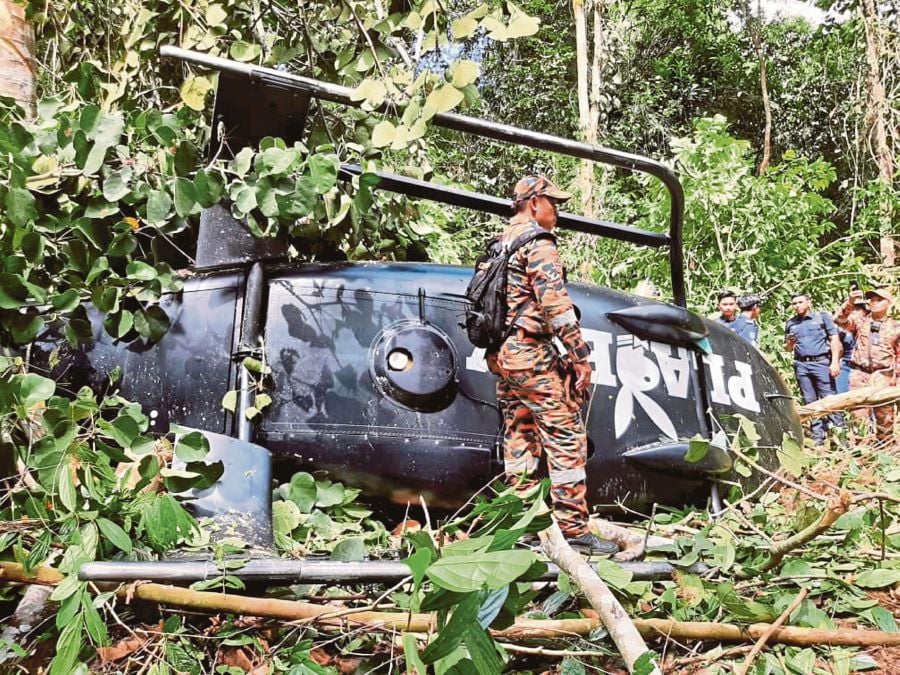KUALA LUMPUR: The Civil Aviation Authority of Malaysia (CAAM) must look into the shortcomings of its oversight regarding the training of United States Federal Aviation Authority (FAA) licence holders in Malaysia.
The Air Accidents Investigation Board (AAIB) said this in its report on Airbus Helicopters Eurocopter EC120B, which crashed in the Chikus Forest Reserve near Kampung Kenangan, Bidor, Perak on Sept 11 last year.
The investigation revealed the accident was a combination of bad weather and a pilot who was neither well versed with flying in adverse weather conditions nor fully capable of handling the aircraft he was in command of.
AAIB said the weather was a highly probable contributing factor to the accident based on the meteorological report that day.
"Additionally, the radar data indicated that the aircraft had a very high rate of descent before impact suggesting that the pilot in command (PIC) had lost control of the aircraft before impact.
"Therefore it was classified the accident as an unintended flight in instrument meteorological conditions (UIMC) which led to loss of control-inflight (LOC-I).
The report said the pilot failed to depress the avionic button controls of the attitude indicator, which was examined by the manufacturer after the crash.
"Airbus Helicopters found that the push button 'AVIONIC' was not activated, which led to the de-energising of the attitude indicator.
"This has very serious implications, especially in bad weather, since the avionic button controls the artificial horizon instrument."
The attitude indicator referred to as the gyro horizon or artificial horizon, informs the pilot of an aircraft of its orientation relative to the earth's horizon.
It serves as a primary guide in instrument meteorological conditions (IMC) where weather conditions require pilots to fly primarily by reference to flight instruments.
Therefore under Instrument Flight Rules (IFR), the pilots who are flying the aircraft will refer to their instruments as opposed to flying using outside visual references under the Visual Flight Rules (VFR).
The AAIB report also said that statements gathered from pilots who had previously flown with the victim indicated he was not very well versed in flying in local adverse weather conditions.
"One such instance was he decided to climb in altitude when his path was blocked by bad weather, instead of keeping low and in sight of the ground and potential landing sites in case the weather deteriorated further."
The report added that statements from ground crew had also indicated that the pilot was not well-versed in the operation of certain switches in the aircraft.
"There were instances where he did not know how to switch off the landing lights and at times flew without depressing the 'AVIONIC' button."
"As such, CAAM is to look into the shortcomings of its oversight regarding the training of FAA licence holders flying in Malaysia."
The helicopter with registration N409HH was operated by Flystar Global Sdn Bhd and was flown by the pilot, a Hong Kong national, Richard Chan Tsz Kin.
The helicopter with one pilot in command took off from the Sultan Abdul Aziz Shah Airport, Subang, Selangor at 11.37am on Sept 11 last year for a private flight and was scheduled to land at 12.37pm at the Sultan Azlan Shah Airport, Perak before it lost contact with air traffic control at 12.16pm.
The Kuala Lumpur Aeronautical Rescue Coordination Centre (KLARCC) in the Kuala Lumpur Air Traffic Control Centre (KLATCC) was immediately activated to determine the helicopter's location.
The pilot was found alive about 20 hours later, but died due to his head injuries during the evacuation from the crash site.


